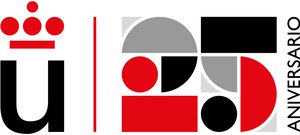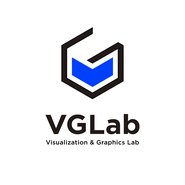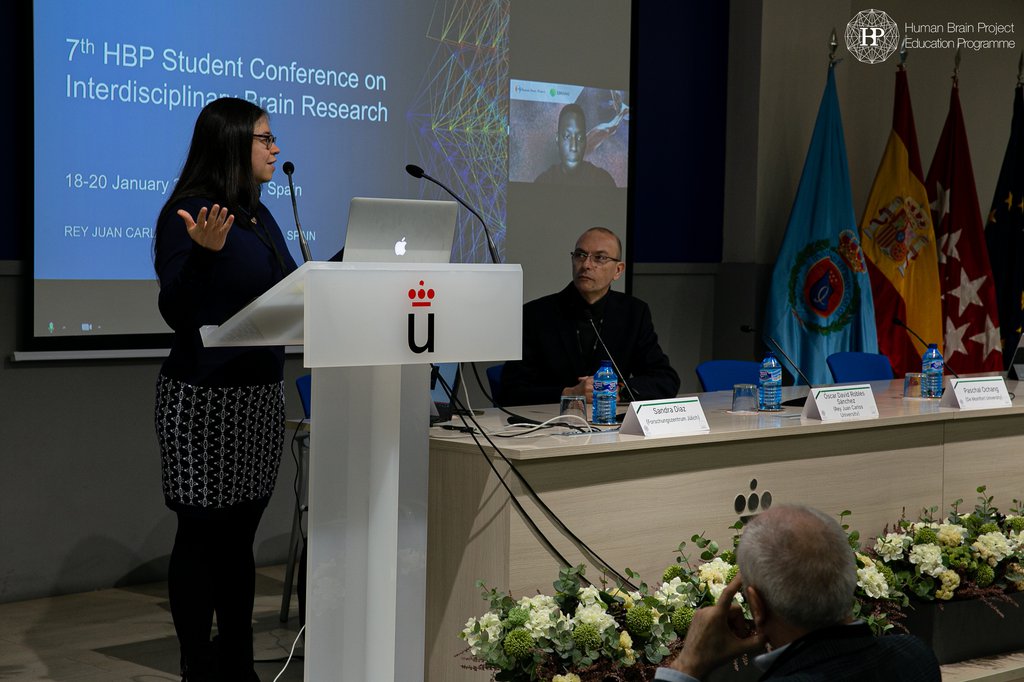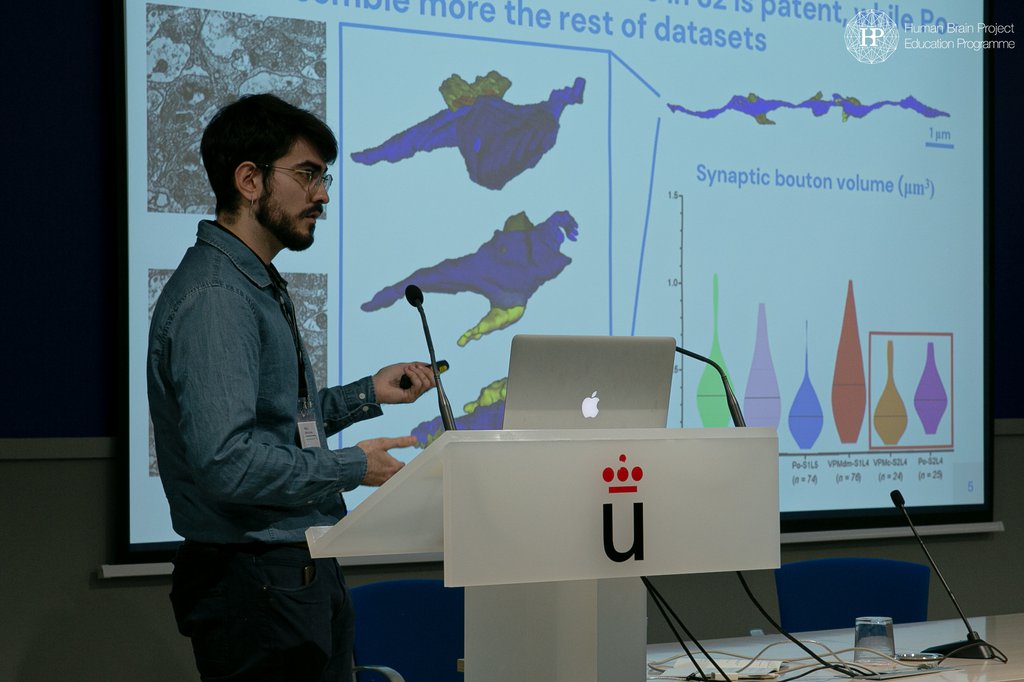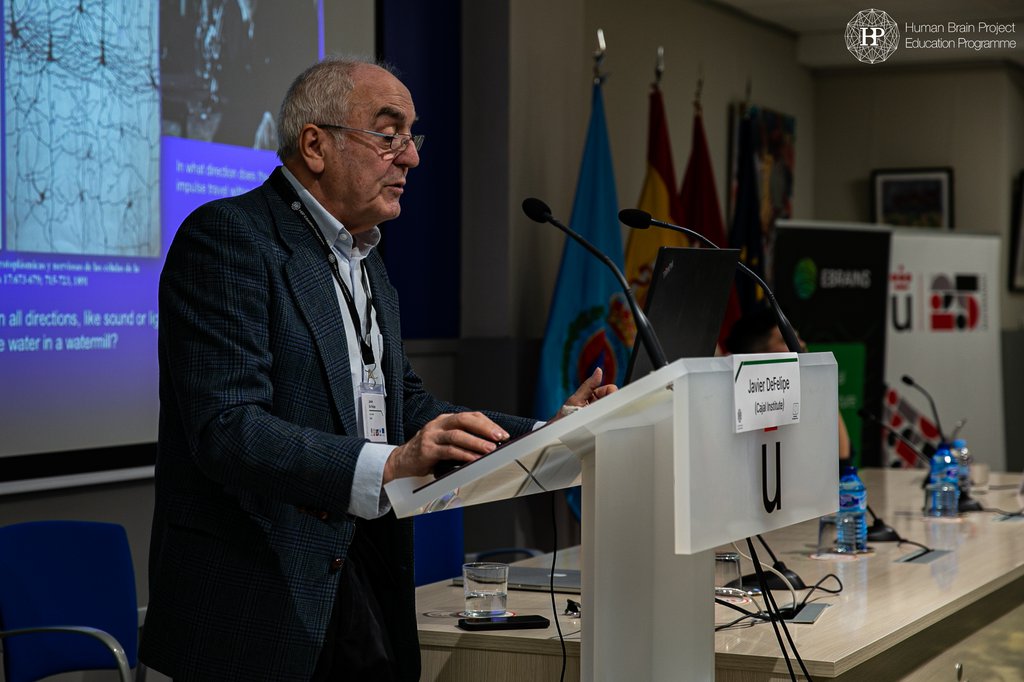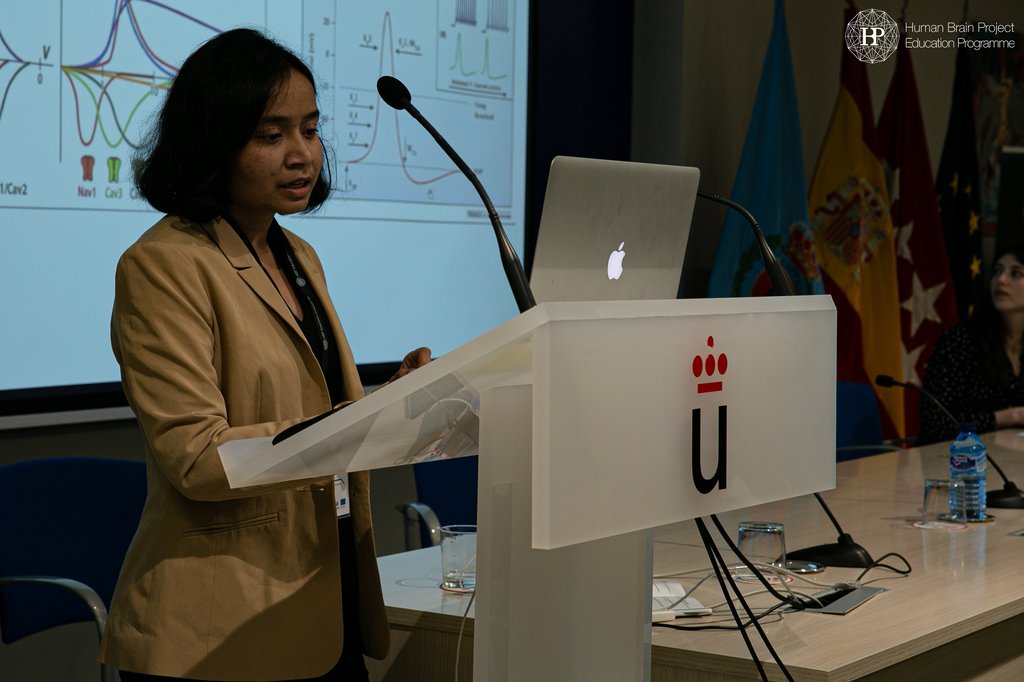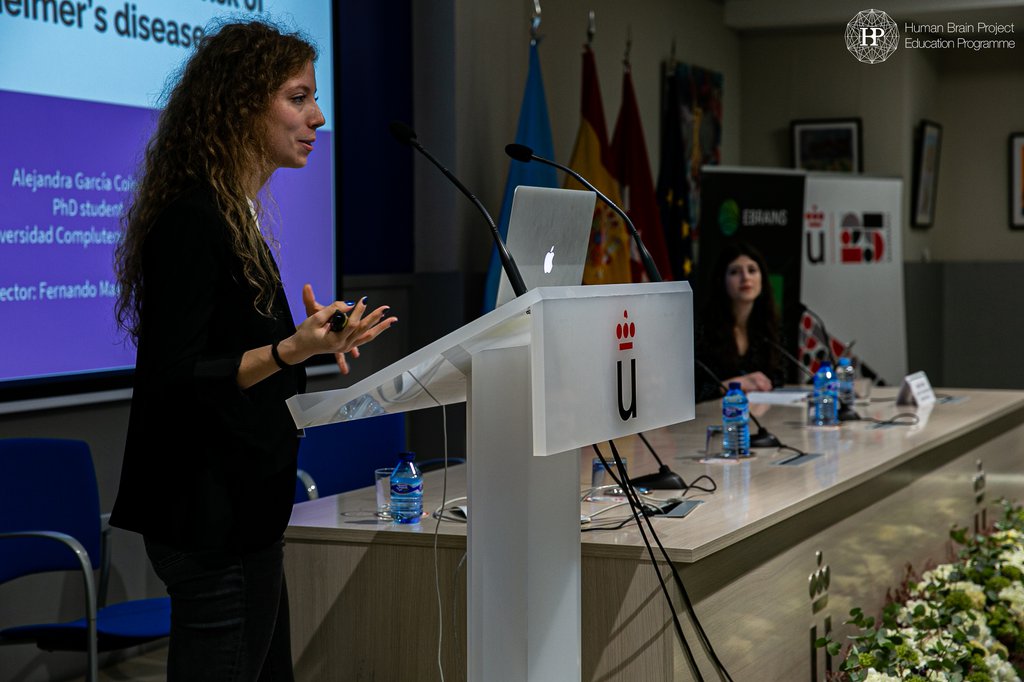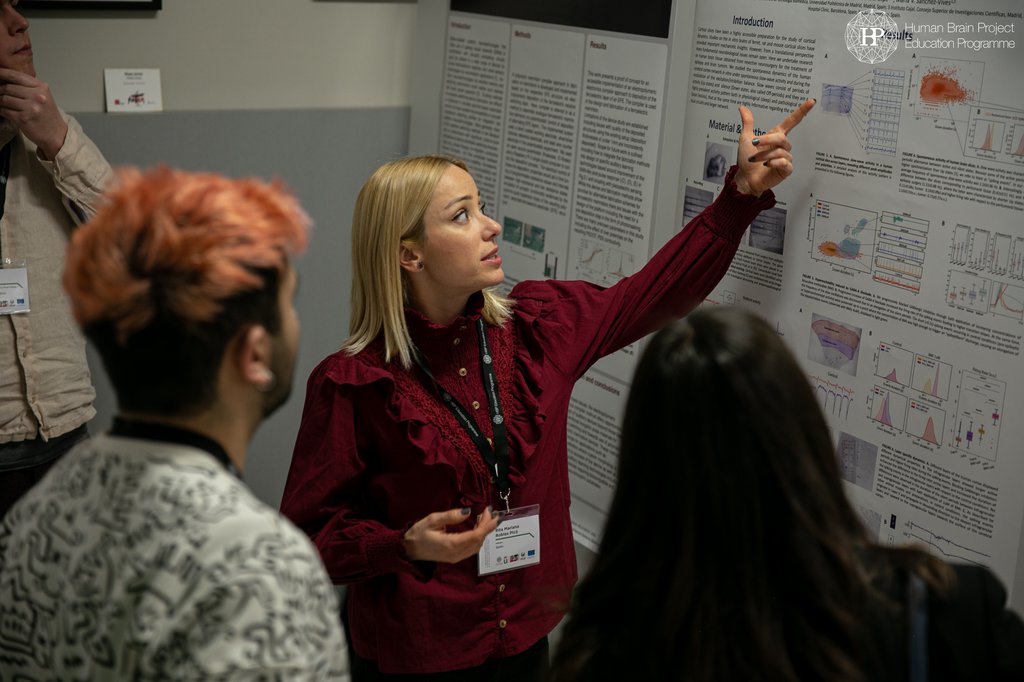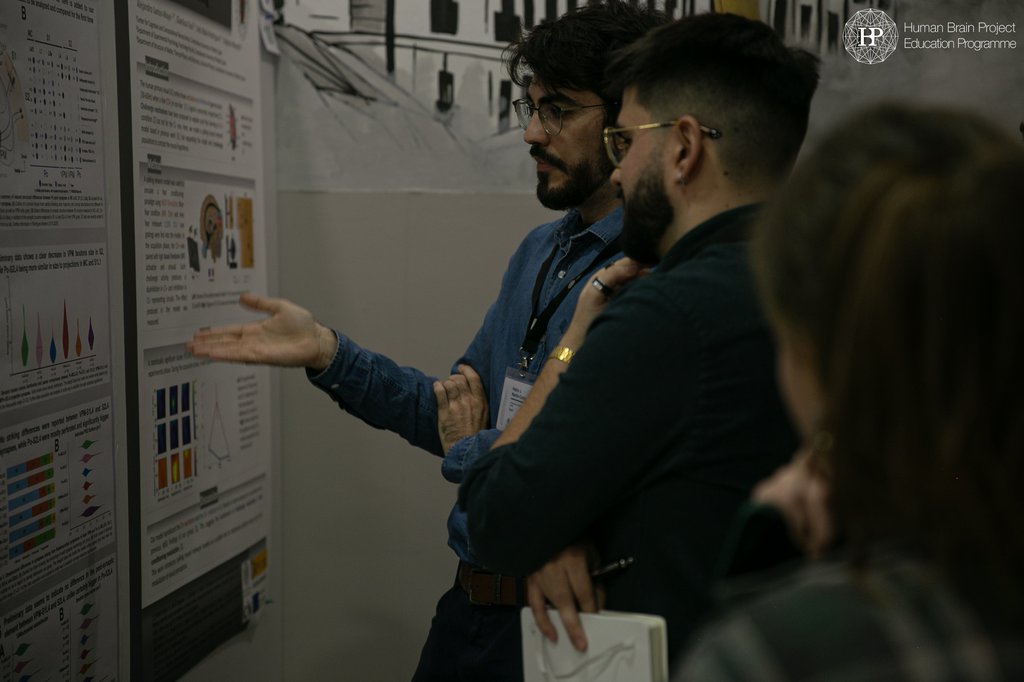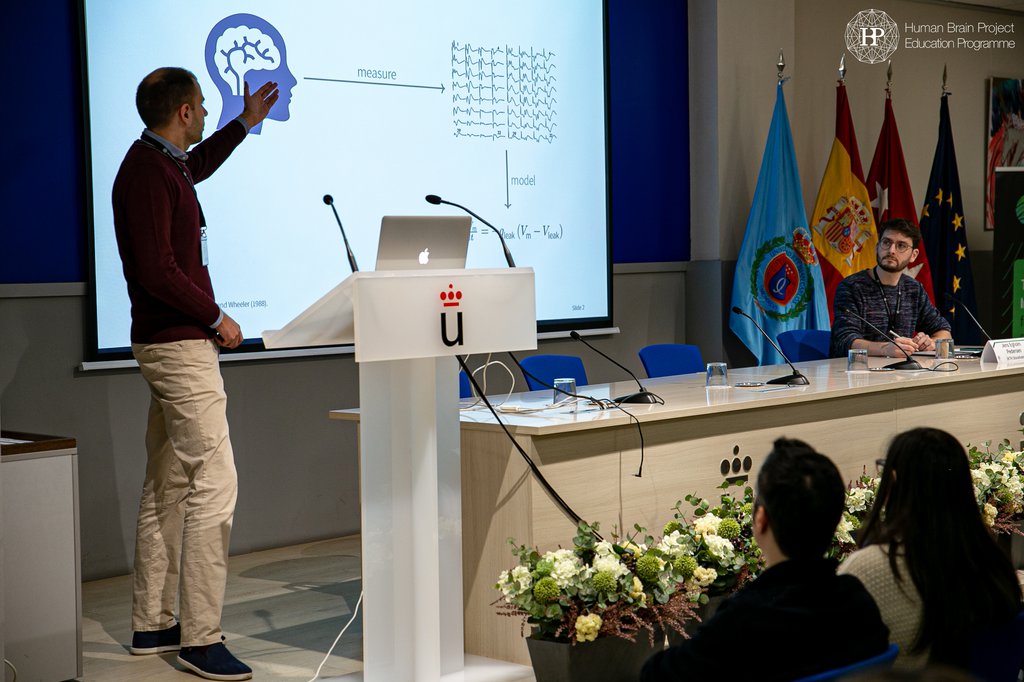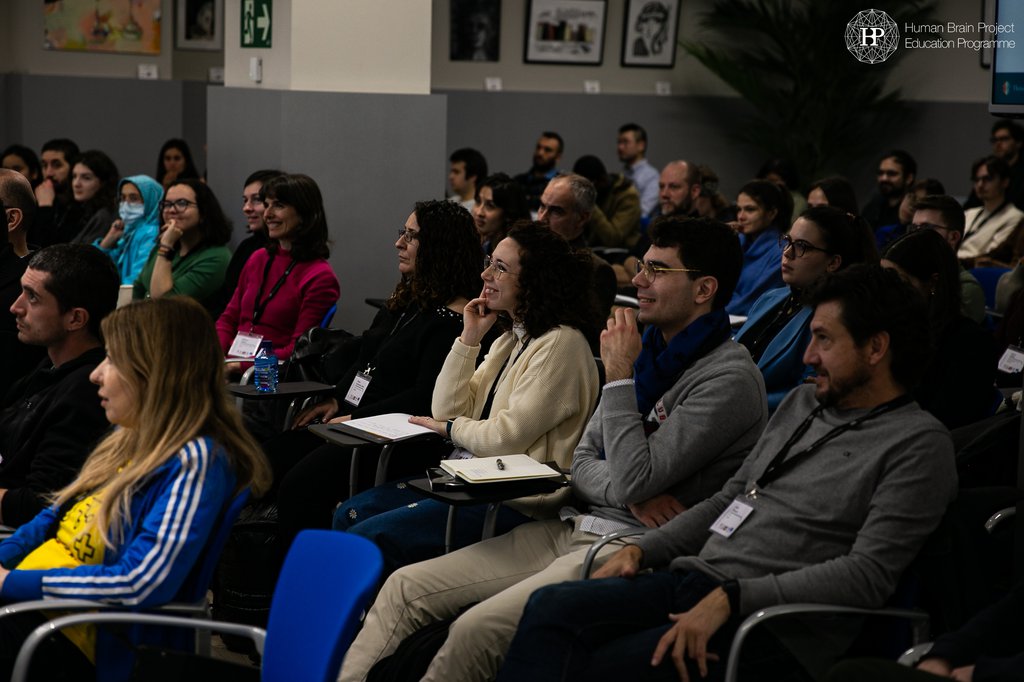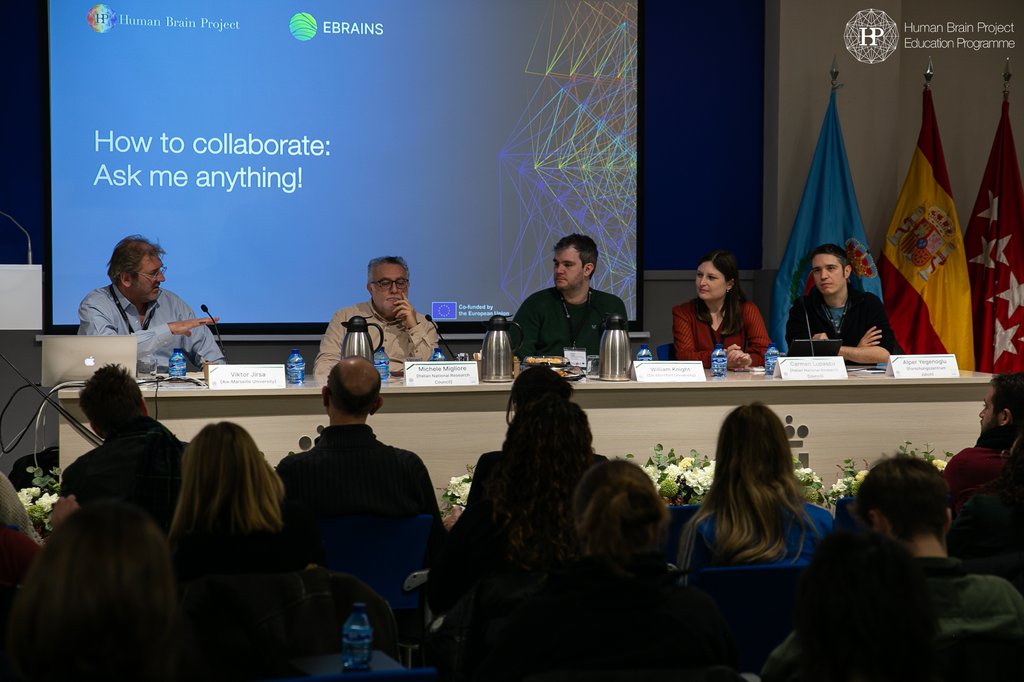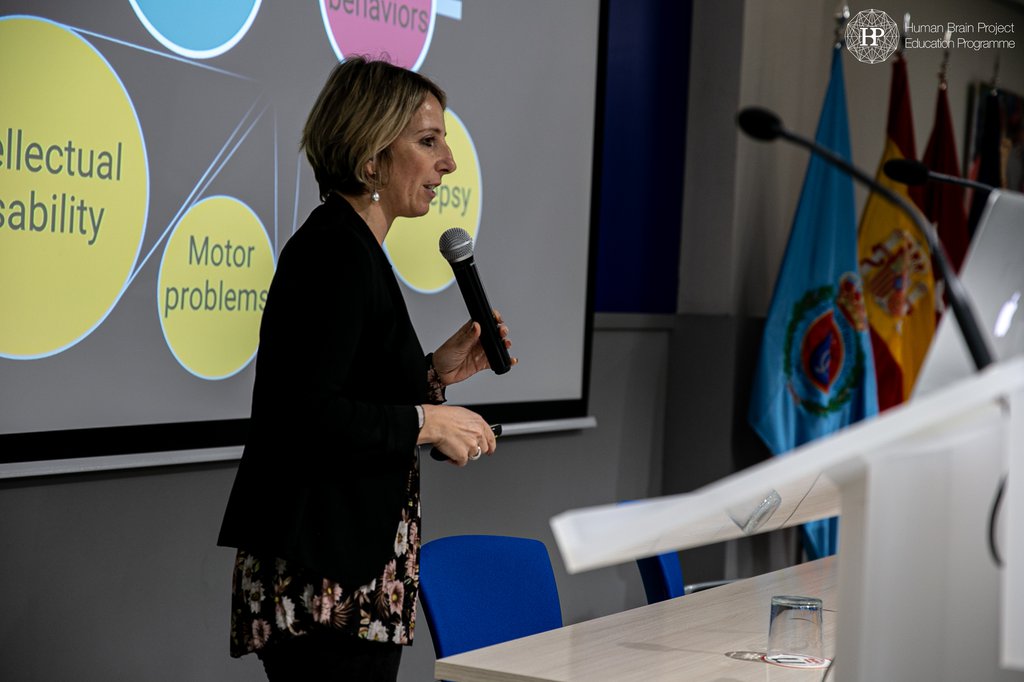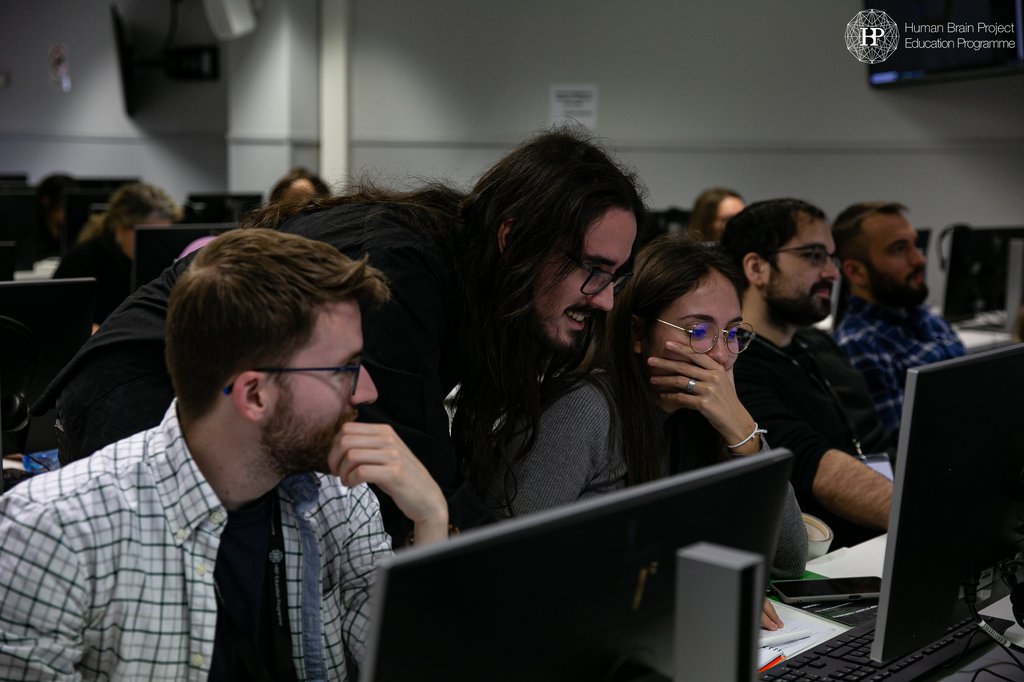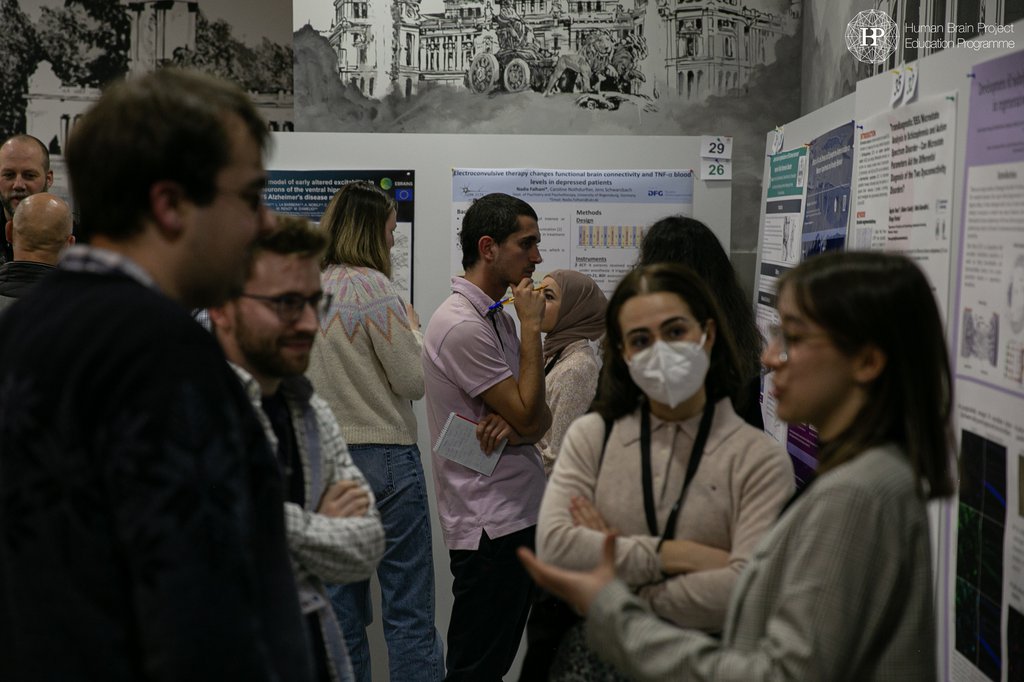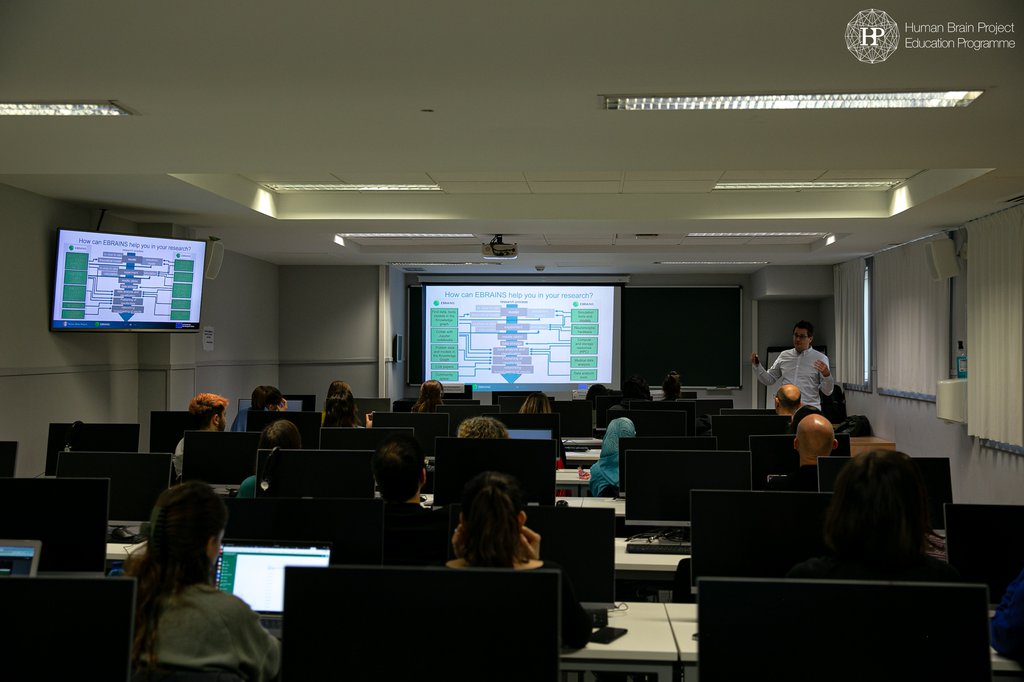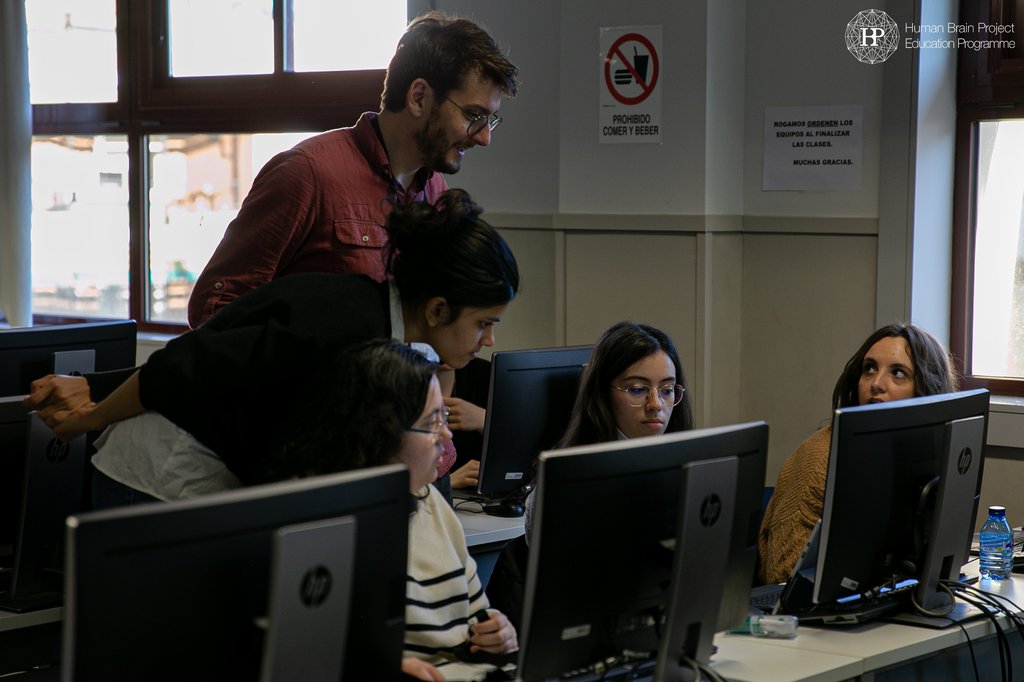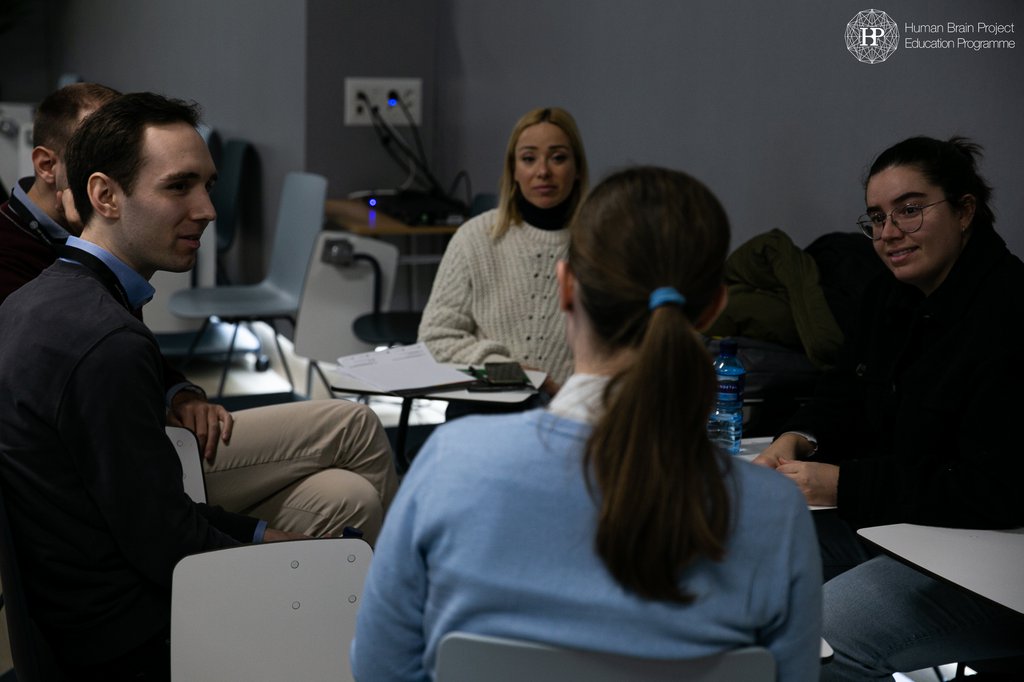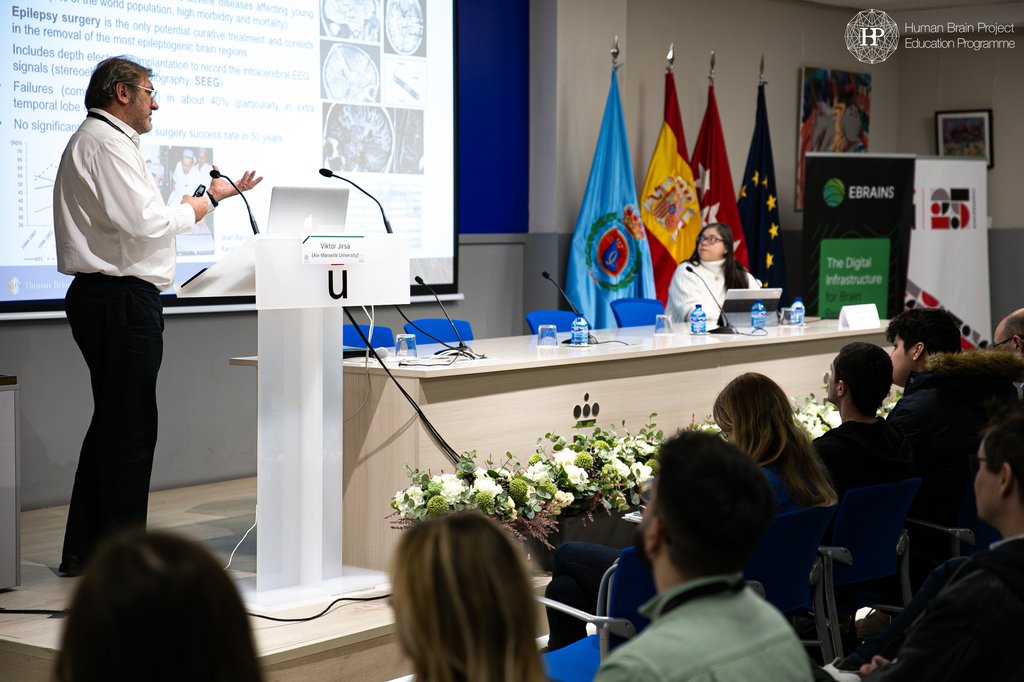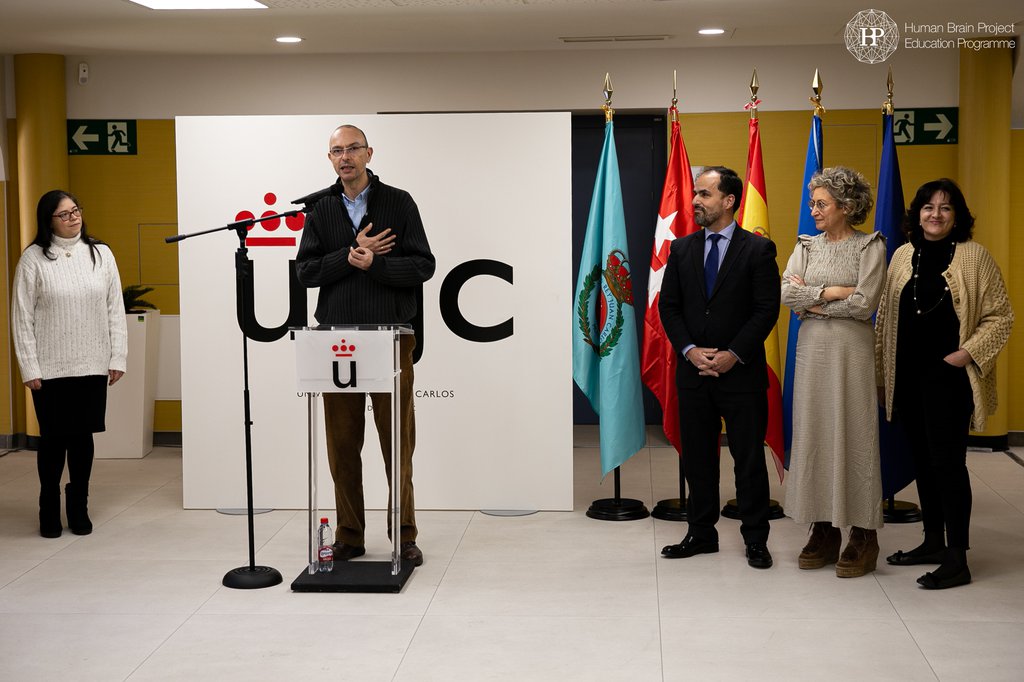HBP Student Conference

7th HBP Student Conference on Interdisciplinary Brain Research
18–20 January 2023
Rey Juan Carlos University, Madrid, Spain
Download the Scientific Programme Booklet 3.4 MB
Check out the recorded keynote lectures
Registration is closed.
About
The human brain is such a complex system that it can only be understood by combining knowledge and practices from multiple scientific fields. The 7th HBP Student Conference on Interdisciplinary Brain Research provided an open forum for the exchange of new ideas among early-career researchers working across various sciences relevant to the Human Brain Project (HBP). Attendees were exposed to the data-driven and multidisciplinary brain research approach of the HBP and had the opportunity to use the EBRAINS platform. The conference offered a space for extensive scientific dialogue, both intra- and interdisciplinary, among peers and faculty through a variety of discussion sessions, lectures, workshops & hands-on training sessions and social events. It took place as an on-site event, organised and supported by the HBP Education Programme.
Participation in the 7th HBP Student Conference was open to the entire student community and early career researchers, regardless of whether they are affiliated with the HBP or not. Participants were also welcome to participate without contributions to the scientific programme. We encouraged all young scientists to register and aim for an equal representation of all genders.
The 3-day conference took place from 18-20 January 2023 in Madrid, Spain.
Picture Gallery
Social
Programme
This images are property of Patrimonio Nacional de España (National Heritage of Spain), extracted from https://www.patrimonionacional.es/visita/palacio-real-de-aranjuez
Closing Reception with a guided tour of the Royal Palace in Aranjuez
The local host of this year’s conference, the Rey Juan Carlos University, invited all registered on-site participants and speakers to experience the Spanish National Heritage, the Royal Palace of Aranjuez. This amazing architectural structure of Habsburg classicism, surrounded by approx. 111 hectares of visible garden is not named an UNESCO World Heritage Site for nothing!
The University itself hosts part of their Campus in the Royal Site and Villa of Aranjuez and will offer all registered on-site participants and speakers an unique experience in our Closing Reception on Friday, 20 January 2023 leaving from the conference venue at 14:15 CET.
Registered participants received an invitation to register for this unique event via email.
Transportation to and from the site was provided by the University for participants and speakers registered for this event.
Schedule:
14:15 – 15:00 |
Travel from Madrid to Aranjuez |
15:00 – 16:30 |
Cocktail Reception and Official Closing of the Conference at Aranjuez University Building |
16:30 – 19:00 |
Walk to the Royal Palace and guided visit through the National Heritage of the Royal Palace https://www.patrimonionacional.es/en |
19:00 – 19:45 |
Travel back to Madrid |
Preliminary Programme
| 08:30 – 09:00 | Registration |
| 09:00 – 09:30 | Welcome & Introduction Sandra Diaz | Forschungszentrum Jülich Paschal Ochang | De Montfort University Local Host Representative | Rey Juan Carlos University |
| 09:30 – 10:30 | Keynote Lecture I: Brain connectomics: From Cajal to present Javier de Felipe | Cajal Institute Chair: Sergio Plaza | Cajal Institute |
| 10:30 – 11:30 | Student Session I: Theoretical Neuroscience Chair: Paschal Ochang | De Montfort University |
| 11:30– 12:00 | Coffee Break |
| 12:00 – 13:00 | Keynote Lecture II: Brain Communication rules for flexible behaviour Helen Barbas | Neural Systems Laboratory, Boston University Chair: Nicolás Cano-Astorga | Cajal Institute |
| 13:00 – 14:00 | Lunch Break |
| 14:00 – 15:00 |
Chair: Giuliano Santarpia | Forschungszentrum Jülich |
| 15:00 – 16:00 |
Chair: Sandra Diaz | Forschungszentrum Jülich |
| 16:00 – 16:30 | Coffee Break |
| 16:30 – 16:50 |
EBRAINS: Enabling the future of brain research |
| 16:50 – 18:20 | Poster Session I |
| 18:20 | Networking Session |
| 08:30 – 09:00 | Registration |
| 09:00 – 11:30 |
|
| 11:30 – 12:00 | Coffee Break |
| 12:00 – 13:00 |
Chair: Jens Egholm Pedersen | KTH Royal Institute of Technology |
| 13:00– 14:00 | Lunch Break |
| 14:00 – 15:00 | Keynote Lecture IV Meta-Learning in Neuromorphic Hardware with Surrogate Gradients Chair: Jens Egholm Pedersen | KTH Royal Institute of Technology |
| 15:00 – 16:00 |
Chair: Carmen Alina Lupascu | Italian National Research Council |
| 16:00 – 16:30 | Coffee Break |
| 16:30 – 18:00 |
Speakers:
Carmen Alina Lupascu | Italian National Research Council
As a young scientist, you work in neuroscience, want to build your career, and expand your network. Have you wondered how other researchers achieved this? A significant part is to create collaborations with your fellow researchers. In this session, we will discuss collaborations and how to foster them. Project investigators, managers, and senior researchers answer your questions about what to look for in partnerships and collaborators and how to maintain them. We invite you to an open conversation with world-leading researchers who share their thoughts and experiences inside and outside HBP and EBRAINS. After a brief introduction from the panelists, they will actively engage in dialogue with the audience. This session is a unique opportunity to interact with world-class researchers—and ask them anything! |
| 18:00 – 19:30 | Poster Session II |
| 08:30 – 09:00 | Registration |
| 09:00 – 11:30 |
Workshop VI (09:00 – 10:00 | Lecture Hall): Workshop VII (10:15 – 11:30 | Lecture Hall):
|
| 11:30 – 12:00 | Coffee break |
| 12:00 – 13:00 |
Multiscale brain modelling for clinical translation in EBRAINS Chair: Sandra Diaz | Forschungszentrum Jülich |
| 13:00 – 13:45 |
Moderators: |
| 13:45 – 14:00 | Awards & Remarks |
| 14:00 – 19:45 | Closing Reception with a guided tour of the Royal Palace in Aranjuez |
Download the Programme at a glance
Workshop Descriptions
Abstract
Extracting useful information from experimental and simulated data is not a straightforward endeavour. The easy representation of models and their interaction with data sources and other simulation and analysis tools is also becoming essential to gain new knowledge and leverage the emerging software infrastructure to study the brain.
We will introduce different visualisation tools which can be used to interactively create, explore and analyse experimental and simulated data, extracting useful information. These tools span along different spatial and temporal scales which describe the function of the brain.
Students will be able to perform different visual exploratory analysis tasks on brain activity datasets from simulations as well as on connectivity data using tools that are currently available as services of EBRAINS.
Finally, we will engage with the attendees in order to know more about their specific scientific projects, about how their interests are covered by the use cases shown, as well as to help them identify the right set of tools from the EBRAINS infrastructure to visualise and interact with data, models and simulations.
Target group
All researchers and students who would like to work with experimental and simulated data with the need of analysing their results. Also all ones interested in visualization and modeling tools for this kind of data.
Expected learning outcome
The participants will learn by doing about some of the available visualization and modeling tools available in EBRAINS, and will have the opportunity to interact with experts and get guidance around the infrastructure tools in order to fit their own specific use cases and scientific goals.
Preparations
No need to prepare in advance.
Workshop Chairs
Óscar David Robles Sánchez | Universidad Rey Juan Carlos
Workshop Speakers
Óscar David Robles Sánchez, Susana Mata Fernández | VG-Lab, Universidad Rey Juan Carlos
Sandra Diaz | SDL Neuroscience, JSC, Forschungszentrum Julich
Bios
 Sandra Diaz Pier works as researcher at the Simulation and Data Laboratory Neuroscience of the Jülich Supercomputing Centre at the Forschungszentrum Jülich in Germany. She has been involved in the HBP since SGA2 and is part of different tasks including high level support and technical integration. She has also taken part in several activities related to the Education Programme of the HBP including student conferences and workshops.
Sandra Diaz Pier works as researcher at the Simulation and Data Laboratory Neuroscience of the Jülich Supercomputing Centre at the Forschungszentrum Jülich in Germany. She has been involved in the HBP since SGA2 and is part of different tasks including high level support and technical integration. She has also taken part in several activities related to the Education Programme of the HBP including student conferences and workshops.
 Susana Mata works as an associate professor at Universidad Rey Juan Carlos in Madrid. She is part of the VG-Lab research group and has been involved in the HBP since the initial ramp-up phase. She has taken part in the development of SimVisSuite, the Simulation Data Visualization Suite, that provides tools for interactive visual exploration of neuroscience data for the analysis of complex scenarios, based on an approach that structures and depicts the information at different levels of abstraction, combining schematic and realistic representations.
Susana Mata works as an associate professor at Universidad Rey Juan Carlos in Madrid. She is part of the VG-Lab research group and has been involved in the HBP since the initial ramp-up phase. She has taken part in the development of SimVisSuite, the Simulation Data Visualization Suite, that provides tools for interactive visual exploration of neuroscience data for the analysis of complex scenarios, based on an approach that structures and depicts the information at different levels of abstraction, combining schematic and realistic representations.
 Óscar David Robles works as associate professor at Universidad Rey Juan Carlos in Madrid. He is part of the VG-Lab research group and has been involved in the HVP since its very beginning. He is currently deputy leader of Task 5.7 in WP5, and has taken part in the development of SimVisSuite, the Simulation Data Visualization Suite, that provides tools for interactive visual exploration of neuroscience data for the analysis of complex scenarios.
Óscar David Robles works as associate professor at Universidad Rey Juan Carlos in Madrid. He is part of the VG-Lab research group and has been involved in the HVP since its very beginning. He is currently deputy leader of Task 5.7 in WP5, and has taken part in the development of SimVisSuite, the Simulation Data Visualization Suite, that provides tools for interactive visual exploration of neuroscience data for the analysis of complex scenarios.
Abstract
Results of brain research, like those of any impactful research, can be used for socially beneficial as well as harmful purposes. How to facilitate beneficial uses and avoid concerning ones is one of the key questions for responsible brain research. To address this question, in the HBP, we have developed a novel approach to address dual use of concern and misuse in brain research. This approach goes beyond the traditional civil-military dichotomy understanding of dual use and considers broader political, security, intelligence and military uses of concern. A range of interdisciplinary and collaborative activities has been launched to continuously identify and discuss any potential concerns and misuse issues, to create networks of responsibility and ‘safe spaces’ to reflect on potential concerns and ways of addressing them. To sum up, responsible brain research involves not only assuming and taking for granted its benefits and intended uses but also continuous reflection on any potential concerns, misuses and unintended uses, and ways to address them.
Target group
Everyone interested in societal and ethical aspects of brain research is welcome. No pre-required knowledge is expected.
Expected learning outcome
The workshop aims to broaden and enrich participants’ understanding of responsible brain research through reflection and interaction. Participants will learn about interdisciplinary and collaborative ways to identify and address potential concerns and misuse issues in their own work by using approaches such as Responsible Research and Innovation and the AREA framework of anticipation, reflection, engagement and action.
Preparations
No need to prepare in advance. If interested, please have a look at our webpage https://www.humanbrainproject.eu/en/social-ethical-reflective/about/dual-use/
Workshop Chair
Inga Ulnicane | De Montfort University
Workshop Speaker
Manuel Guerrero | Uppsala University
Bios
 Inga Ulnicane has more than 15 years of international and interdisciplinary experience of research, teaching and engagement in the field of science, technology and innovation governance, policy, and politics. She has published on topics such as governance and policy of Artificial Intelligence, dual use, international research collaboration, European integration in research, and Grand societal challenges. In addition to academic publications, she has prepared commissioned reports for the European Parliament and European Commission. Currently she is Senior Research Fellow at De Montfort University, Leicester, UK, and chairs the Human Brain Project’s Dual Use Working Group.
Inga Ulnicane has more than 15 years of international and interdisciplinary experience of research, teaching and engagement in the field of science, technology and innovation governance, policy, and politics. She has published on topics such as governance and policy of Artificial Intelligence, dual use, international research collaboration, European integration in research, and Grand societal challenges. In addition to academic publications, she has prepared commissioned reports for the European Parliament and European Commission. Currently she is Senior Research Fellow at De Montfort University, Leicester, UK, and chairs the Human Brain Project’s Dual Use Working Group.
 Manuel Guerrero is a sociologist and bioethicist with extensive experience in human rights. He holds a PhD in Sociology and Postgraduate Diplomas in Medical Ethics and Research Ethics. He is a researcher at the Centre for Research Ethics & Bioethics (CRB) at Uppsala University and Assistant Professor of Bioethics at the Department of Bioethics and Medical Humanities in the Faculty of Medicine and Ethics at the Centre for Applied Ethics in the Faculty of Philosophy and Humanities at the University of Chile. Since 2016 is H2020 Human Brain Project's (EU FET Flagship) Ethics Rapporteur Programme's lead; co-chair of its Dual Use Working Group and member of its Education Programme Committee. His research activities combine philosophy, social sciences and neuroethics, with a focus on the ethical and social implications of brain research and neurotechnologies and the promotion of Responsible Research and Innovation (RRI).
Manuel Guerrero is a sociologist and bioethicist with extensive experience in human rights. He holds a PhD in Sociology and Postgraduate Diplomas in Medical Ethics and Research Ethics. He is a researcher at the Centre for Research Ethics & Bioethics (CRB) at Uppsala University and Assistant Professor of Bioethics at the Department of Bioethics and Medical Humanities in the Faculty of Medicine and Ethics at the Centre for Applied Ethics in the Faculty of Philosophy and Humanities at the University of Chile. Since 2016 is H2020 Human Brain Project's (EU FET Flagship) Ethics Rapporteur Programme's lead; co-chair of its Dual Use Working Group and member of its Education Programme Committee. His research activities combine philosophy, social sciences and neuroethics, with a focus on the ethical and social implications of brain research and neurotechnologies and the promotion of Responsible Research and Innovation (RRI).
Cancelled!
Abstract
Interdisciplinary brain research combines the knowledge of a variety of disciplines, bringing together different insights and schools of thought. Diversity is crucial in brain research as individuals have different brains, shaped by their personal experiences and environments as well as by society.
Horizon Europe highlights the integration of the gender dimension into research and innovation content as a requirement by default. The HBP aims to play a pioneering role in promoting awareness and advancing how gender and diversity are considered in research and innovation. Examples from the field of AI and Machine Learning illustrate that diversity in research is also a key factor in technical innovations and developments.
Sex and gender might intersect with other diversity traits, such as age, race, social background or culture. Additionally, research findings might have different implications for different user groups or stakeholders. Such findings are in the focus of the debate on neurosexism, criticizing that neuroscience of sex differences has partially been interpreted incorrectly to promote traditional gender roles. This debate proves the importance of considering diversity in research, which this workshop will target.
Target group
PhD and Postdocs, EBRAINS internal and external users
Expected learning outcome
- Define diversity in research content, e. g. sex/gender, age, ethnicity, and their intersectionality
- Know how to operationalise gender and further diversity traits in specific fields of science
- Know how to consider diversity throughout the research process
Preparations
Participants are invited to think about questions related to diversity in their own research fields
Workshop Chairs
Karin Grasenick | convelop cooperative knowledge design gmbh
Bio

Karin Grasenick is the founder and managing partner of convelop cooperative knowledge design gmbh, a company, amongst others, addressing topics of equality, diversity and inclusion in research technology and innovation. Karin holds a PhD in biomedical engineering and computer science; the company founded based on her research won the Austrian state prize for innovation. She is a certified CPC and founder of www.conflictpartnership.net, completed numerous additional trainings on solution focused coaching, change and diversity management, gender mainstreaming, inter- and transdisciplinary collaboration.
Karin works as consultant, coach and trainer mainly for universities and companies with STEM focus, on topics such as equality, diversity inclusion and interdisciplinary collaboration. For the HBP, she developed the Gender Action Plan and coordinates its implementation together with the Diversity and Equal Opportunities Committee. The EDI Toolkit (see www.edi-toolkit.org) offers more information and support to consider diversity in research.
Abstract
This workshop teaches you how to exploit the thundering success of deep learning within the domain of computational neuroscience. You will learn about Norse, a bio-inspired extension of the popular deep learning library, PyTorch. Norse adds neuron primitives, plasticity, and learning algorithms to the PyTorch infrastructure, which brings three benefits we will highlight in the workshop: 1) rapid modelling and execution of experiments within minutes, 2) unrestricted combinations of biological and artificial neural network primitives and learning rules, and 3) translation of network models to high-performance computing clusters and neuromorphic hardware. Finally, the workshop provides a brief exposition on useful community-based tools to increase your productivity.
Target group
Computational neuroscientists, computer scientists, data scientists.
Expected learning outcome
Using Norse, participants will learn to 1) simulate and optimize bio-inspired spiking neural networks, 2) combine learning principles from artificial and spiking neural networks, and 3) use the network accelerator PyTorch Lightning to increase productivity and training speed.
Preparations
Participants only need a computer with internet access. Experience with Python is an advantage, but not a requirement.
Workshop Chairs
Jens E. Pedersen | KTH Royal Institute of Technology
Workshop Speakers
Jens E. Pedersen, Harini Sudha Jembu | KTH Royal Institute of Technology
Christian Pehle | University of Heidelberg
Bios
 Jens E. Pedersen is a doctoral student working with neuromorphic control systems at the neurocomputing systems lab at KTH, Sweden. He is a co-author of the spiking neural network library, Norse, and used to work at CERN, Switzerland.
Jens E. Pedersen is a doctoral student working with neuromorphic control systems at the neurocomputing systems lab at KTH, Sweden. He is a co-author of the spiking neural network library, Norse, and used to work at CERN, Switzerland.
 Christian G. Pehle is a postdoc in physics at the Kirchoff institute of physics at the University of Heidelberg. He is a co-author of the spiking neural network library, Norse, and pioneered the EventProp optimization algorithm for spiking neural networks.
Christian G. Pehle is a postdoc in physics at the Kirchoff institute of physics at the University of Heidelberg. He is a co-author of the spiking neural network library, Norse, and pioneered the EventProp optimization algorithm for spiking neural networks.
 Harini Sudha J G is a master's student at the Indian Institute of Science Education and Research, Pune, India. Her specialised focus is in computational neuroscience. She is pursuing her master's thesis at KTH Royal Institute of Technology, Stockholm, Sweden building spiking neural networks for low latency collision avoidance in mobile robots. She has previously worked on understanding decision making and emotion recognition in the brain using modelling techniques and machine learning. She aspires to connect neuroscientific concepts and their applications.
Harini Sudha J G is a master's student at the Indian Institute of Science Education and Research, Pune, India. Her specialised focus is in computational neuroscience. She is pursuing her master's thesis at KTH Royal Institute of Technology, Stockholm, Sweden building spiking neural networks for low latency collision avoidance in mobile robots. She has previously worked on understanding decision making and emotion recognition in the brain using modelling techniques and machine learning. She aspires to connect neuroscientific concepts and their applications.
Abstract
EBRAINS is a European research infrastructure for neuroscience that allows scientists to explore data, create models of the brain, simulate and analyse brain behaviour at multiple scales. Thereby emerging computational limitations are addressed by enabling access to high-performance computing or brain-inspired computing technologies. All results, as well as experimental data, can be shared with the community easily and robustly following FAIR principles.
This workshop will provide a quick overview of the different tools and services available in EBRAINS. As EBRAINS advocates FAIR principles, we will also show how the different tools can be integrated into FAIR workflows using Common workflow language. If participants wish to learn more about a particular tool or how to use EBRAINS for their specific use case, they may contact the workshop chair beforehand (c.bachmann@fz-juelich.de) or bring their questions with them to the event. During the workshop, we will discuss these questions interactively. Thus, the purpose of this workshop is to allow researchers to get creative and combine the various EBRAINS components to respond to existing questions and investigate new avenues through collaboration, sharing, co-design, and innovation.
Target group
- Young Researchers that are new in EBRAINS
- Established EBRAINS users who would like to get inspiration for broadening their research scope
Expected learning outcome
Minimum: On overview of what services/tools are offered by EBRAINS;
Maximum: What are the concrete tools /services that I can use for my research and where do I find more information about them. Obtaining a conceptual idea for creating FAIR workflow in EBRAINS.
Preparations
Participants are welcome to bring one figure/image that relates to their research interests. This would serve as the basis for further discussion of how EBRAINS can help them implement their science. In addition, they may contact the chair in advance with more specific questions that will be discussed during the workshop.
Workshop Chairs
Claudia Bachmann / Forschungszentrum Jülich
Workshop Speakers
Marissa Diaz Pier | FZ Jülich
Sofia Karvounari, Eleni Mathioulaki | Athena Research Center
Bio
 Claudia Bachmann:
Claudia Bachmann:
2012 Diploma inf Biology, University of Freiburg
2019 PhD in Biology, Forschungszentrum Jülich/ RWTH Aachen University, Institute of Biology
2021 – today Scientific Liaison Unit Officer for EBRAINS
Abstract
In this workshop, participants will learn about the responsible data governance approach created for HBP/EBRAINS and understand how to develop good data governance practices in the different stages of their data lifecycle and workflows. This is vital as the collection, processing and curation of brain data increasingly raise a number of societal concerns including privacy and confidentiality, security, trust, misuse, bias and discrimination. The concerns are compounded because brain data crosses national and regional boundary lines and interact with different ethical principles, laws, regulations, and policies. Responsible data governance is used by HBP/EBRAINS to address such issues. Data governance is a collection of principles, procedures, processes, frameworks, policies and rules that ensure acceptable, responsible, and efficient processing of data in a way to achieve organizational goals and be compliant with relevant regulations. It establishes the processes and responsibilities that ensure the availability, usability, security and quality of data processed. It defines who, what, how and when is processed in an efficient and responsible way. The idea of responsible data governance combines this description of data governance with the approach of Responsible Research and Innovation (RRI).
Target group
PhD students, postdocs, faculty, Pis
Expected learning outcomes
This workshop aims to provide participants with necessary skills to implement responsible data governance principles in their data processing pipelines.
Preparations
None
Workshop Chair
Damian Eke | De Montfort University
Workshop Speakers
Damian Eke | De Montfort University
William Knight | De Montfort University
George Ogoh | De Montfort University
Bio

Dr Damian O. Eke is Research Fellow at the Centre for Computing and Social Responsibility (CCSR) at De Montfort University, UK. Damian is the Data Governance coordinator for the EU Human Brain Project. His research interests cover critical philosophical issues at the intersection of Technology, Data and Society including; Data Governance, Ethics of Emerging Technologies, Responsible Innovation and ICT4D.

Dr William Knight is a Senior Research Fellow at the Centre for Computing and Social Responsibility at De Montfort University, and the Ethics Compliance Manager for the Human Brain Project. His research focuses on ethics compliance, data governance and data protection for large scale research projects.

Dr George Ogoh is a Research Fellow at the Centre for Computing and Social Responsibility at De Montfort University. He has a Computer Information Systems background and a PhD in Computing and Social Responsibility from De Montfort University. His research for the Human Brain Project (HBP) covers a wide range of ethics-related topics at the intersection of brain research and neurotechnology and includes themes on Responsible Research and Innovation (RRI), responsible innovation, diversity and equality, data governance, and data protection.
Abstract
The HBP Innovation team (UPM) will present several options to successfully transfer and exploit your most mature scientific achievements. Different knowledge transferring modalities will be reviewed in this session to help researchers to move, in practice, their results to the scientific, industrial, and clinical markets, thus contributing to get more positive and stronger impacts in society. Also, one neurotechnology company will be presented as entrepreneurship example.
Target group
Researchers and students (Neuroscience and Neurocomputing domains) with a solid entrepreneurship motivation and interest in exploring new ways to work and cooperate with business actors beyond Academia.
Expected learning outcome
Exploitation and technology transferring conceptualisation; Business models analysis; Start-up creation and funding strategies.
Preparations
No need to prepare in advance.
Workshop Chairs
Bárbara Gasset, Guillermo Velsaco | Universidad Politécnica de Madrid
Workshop Speakers / Tutors
Guillermo Velasco | Universidad Politécnica de Madrid | guillermo.velasco@upm.es
Alejandro Fernández | Universidad Politécnica de Madrid | alejandro.fernandez.munoz@upm.es
Blanca Beltrán | Universidad Politécnica de Madrid | blanca.beltran@upm.es
Javier Mínguez | Bitbrain | javierminguez@bitbrain.es
Bios

Guillermo Velasco is leader of the Human Brain Innovation team, by the Universidad Politécnica de Madrid, and Leader of the EBRAINS Spanish Node. Expert in Technology transfer, Technology foresight and Future studies for Innovation. Expert in strategic intelligence tools for RDTI and evaluation of innovation policies. Honorary research fellow on Foresight and Innovation, Manchester Institute of Innovation Research.
 Blanca Beltrán
Blanca Beltrán
Market Analysis and researcher at HBP Innovation Team, by the Universidad Politécnica de Madrid. Expert in translating innovative scientific research into industrial solutions. Economics and law graduate, currently specialising in cognitive neuroscience and biopsychology.
 Alejandro Fernández
Alejandro Fernández
Market analyst and innovation researcher at the HBP Innovation Team, specialised in startups and funding instruments. Physics graduate and MSc in nanophysics and innovation economics and management. Honorific Mention in Science in Technology in Spain’s National Youth Awards 2022, for founding and leading the biggest physics students’ organization of the country.
 Javier Mínguez
Javier Mínguez
Bitbrain Chief Scientific Officer (CSO) | R&D Department
Professor of Computer Science and Lecturer of Neurotechnology in the Neuroscience Biomedical and Engineering Schools at the University of Zaragoza (Spain), and invited lecturer and researcher at 10+ academic institutions such as Stanford University, IE Business School, etc Co-founder of Bitbrain, global leading company in the development of neurotechnologies for markets like Health, Market Research, Enterteinment, etc. 110+ research publications and 5+ patents in the areas of neuroscience, neural engineering, brain-machine technology, human-computer interaction, cognitive and motor neurorehabilitation, intelligent robotics, and market research. R&D achievements: several early prototypes of robots controlled by brain-computer interfaces (a wheelchair, a telepresence robot and a robotic arm), the first neurotechnology for personalized cognitive enhancement, and the first neurotechnology for emotion/engagement detection in market research. Received 25+ international awards such as the Iberoamerican Award to Innovation and Entrepreneurship, the second prize in the European Commission-ICT Best Company and Best Investment Opportunity, and the International Entrepreneur Award of the Everis Fundation. Speaker at 300+ events related to research and innovation such as the Real Academy of Medicine of Spain, the ICT EU Conference, several IEEE International Conferences, Campus Party, etc. Executive of IEEE Spanish Robotics section, having been called several times to defend the Spanish interests in the EU R&D roadmaps. R&D featured in Wired, New Scientist, BBC, The Economist, The Telegraph, CNN, Daily News, Business Because; and TVE, Antena3, TeleCinco, Cuatro, La Sexta, El Mundo, El país, Muy Interesante, ...
Abstract
Founded by Santiago Ramón y Cajal in 1920, the Cajal Institute has been devoted to the study of the nervous system, contributing to the unstoppable progress of neuroscience in the last century and becoming a worldwide reference for generations of brain researchers.
Apart from its scientifical activities, the institute also keeps the Cajal Legacy, an incredible and vast collection of the belongings of Santiago Ramón y Cajal, father of modern neuroscience and Nobel prize winner in physiology and medicine in 1906. The National Museum of Natural Sciences of Madrid, in collaboration with the Cajal Institute, is now hosting an outstanding exhibition of this material. During the visit to the museum, participants will get the chance to see a unique collection of original works and drawings from Cajal, including the Nobel prize winner award, as well as some other historic pieces and tools he used to redesign neuroscience.
This visit represents a unique opportunity to experience the birth of modern neuroscience.
Preparations
How to get there: The Museum is located at C/ José Gutierrez Abascal, 2. Participants could get there by metro (Metro stations of: Gregorio Marañón (lines 7 and 10), Nuevos Ministerios (lines 6, 8 and 10), República Argentina (line 6), Ríos Rosas (line 1)) and by bus (lines 7, 12, 14, 27, 40, 45, 147 y 150).
Confirmed Keynote Speakers

Helen Barbas is Professor at Boston University and School of Medicine. She studied neuroscience at McGill University (PhD) and Harvard Medical School (postdoctoral). She established the Neural Systems Laboratory at Boston University, funded by grants from the National Institutes of Health (NIMH and NINDS), the National Science Foundation and Autism Speaks. Her research focuses on the organization of the cerebral cortex, and specifically on the pattern and synaptology of prefrontal pathways with excitatory and inhibitory systems associated with cognition, memory and emotions. Her work has led to establishment of the predictive Structural Model, which links the laminar structure of the cortex to connections, cortical development, the stability/plasticity continuum of areas, and preferential vulnerability of areas to neurodegenerative and psychiatric diseases.
Keynote Lecture II: Brain communication rules for flexible behaviour
Cortical connections are strongly related to the systematic variation of the cortical landscape across systems. Pathways from cortical and subcortical structures give the prefrontal cortex a panoramic view of the sensory environment and the internal milieu of motives and drives. The prefrontal cortex also receives information from the hippocampus and the amygdala, and innervates widely the inhibitory thalamic reticular nucleus that gates thalamo-cortical communication. The laminar distribution, strength, presence or absence of connections can be predicted by the Structural Model, based on the systematic cortical variation, which and can be traced to development. The model suggests dynamic recruitment of areas for flexible behavior. Within this context, the connections of the prefrontal cortex have distinct implications for executive control, learning and memory, and vulnerability in psychiatric and neurologic diseases.
 Viktor Jirsa is Director of the Inserm Institut de Neurosciences des Systèmes at Aix-Marseille-Université and Director of Research at the Centre National de la Recherche Scientifique (CNRS) in Marseille, France. Dr. Jirsa received his PhD in 1996 in Theoretical Physics and has since then contributed to the field of Computational Neuroscience with a focus on networks and dynamics. His research has been foundational for network science in medicine, leading to novel technologies for personalized brain modeling and clinical translation in epilepsy. Dr. Jirsa is Chief Science Officer of the European Digital Neuroscience Infrastructure EBRAINS. He leads the brain simulation platform The Virtual Brain (www.thevirtualbrain.org) and is lead scientist in the European flagship Human Brain Project (https://www.humanbrainproject.eu/). Dr. Jirsa has been awarded several international and national awards including the Human Brain Project Innovation Prize (2021) and Grand Prix Départemental de Recherche en Provence (2018). Dr. Jirsa serves on various Editorial and Scientific Advisory Boards and has published more than 160 scientific articles and book chapters, as well as co-edited several books including the Handbook of Brain Connectivity.
Viktor Jirsa is Director of the Inserm Institut de Neurosciences des Systèmes at Aix-Marseille-Université and Director of Research at the Centre National de la Recherche Scientifique (CNRS) in Marseille, France. Dr. Jirsa received his PhD in 1996 in Theoretical Physics and has since then contributed to the field of Computational Neuroscience with a focus on networks and dynamics. His research has been foundational for network science in medicine, leading to novel technologies for personalized brain modeling and clinical translation in epilepsy. Dr. Jirsa is Chief Science Officer of the European Digital Neuroscience Infrastructure EBRAINS. He leads the brain simulation platform The Virtual Brain (www.thevirtualbrain.org) and is lead scientist in the European flagship Human Brain Project (https://www.humanbrainproject.eu/). Dr. Jirsa has been awarded several international and national awards including the Human Brain Project Innovation Prize (2021) and Grand Prix Départemental de Recherche en Provence (2018). Dr. Jirsa serves on various Editorial and Scientific Advisory Boards and has published more than 160 scientific articles and book chapters, as well as co-edited several books including the Handbook of Brain Connectivity.
Keynote Lecture V: Multiscale brain modelling for clinical translation in EBRAINS
The past two decades have seen enormous progress in the development of virtual brain technologies, primarily due to progress in brain imaging and high-performance computing. Virtual brains integrate an individual’s brain imaging data into a computational representation of a brain model and make it a personalized in-silico brain simulation platform. Since its initial proposal in 2002, virtual brains have been systematically built for the mouse, macaque and human and their individual predictive value has been established, regularly outperforming generic brain models. One reason for this success is the consideration of variability of individual connectivity in the brain model. A connectome is the set of all neuronal connections, which can be estimated using Diffusion Tensor weighted Imaging (DTI) obtained in Magnetic Resonance Imaging (MRI). Virtual brains are constructed around an individual’s connectome, which characterizes the information transfer between even far distant brain areas. In case of injury or disease, such as stroke, neurodegeneration or epilepsy, the communication between brain areas is impaired and results in pathological brain activity. Virtual brains mimic the cause of such miscommunication and provide the capacity to simulate alternative treatments based on the individual’s connectome. A second source of predictive power is the inclusion of high-resolution data at spatial scales of up to 10mm. Such data exist only ex-vivo, which poses challenges to the integration with in-vivo data in a personalized brain modeling strategy. The two approaches can be integrated through application of latest techniques in Bayesian inference and Monte Carlo simulation, in which generic high-resolution brain templates are morphed to accommodate the patient’s brain imaging data, leading to a maximum predictive power for a given individual.We illustrate the virtual brain workflow along the example of drug resistant epilepsy, the so-called Virtual Epileptic Patient (VEP): we reconstruct the connectome of an epileptic patient using DTI and co-register other potential imaging data from the same individual (anatomical MRI, computer tomography (CT)). Each brain region is represented by neural population models, which are derived using mean field techniques from statistical physics expressing ensemble activity via collective variables. Subsets of brain regions generating seizures in patients with refractory partial epilepsy are referred to as the epileptogenic zone (EZ). During a seizure, paroxysmal activity is not restricted to the EZ, but may recruit other healthy brain regions and propagate activity through large brain networks. The identification of the EZ is crucial for the success of neurosurgery and presents one of the historically difficult questions in clinical neuroscience. The application of Bayesian inference and model inversion, in particular Hamiltonian Monte Carlo, allows the estimation of the patient’s EZ, including estimates of confidence and diagnostics of performance of the inference. The example of epilepsy nicely illustrates the workflow of end-to-end modeling and the predictive value of personalized large-scale brain network models. Currently the VEP technology is validated in a large multisite clinical trial EPINOV with 400 prospective epilepsy patients. The Virtual Brain is the dedicated full brain simulator in the European digital neuroscience research infrastructure EBRAINS and enables neuroscientists worldwide to build and estimate personalized virtual brains.
 Javier DeFelipe begins his research career in 1976 at the Instituto Cajal (CSIC) where he began to study the microorganization of the cerebral cortex, a subject that has remained the focal point for his research since then. At present he is a Research Professor in the same institution. His particular expertise lies in 3D electron microscopy and the correlation of electron microscopy data with the synaptic connectivity of neurons previously identified using functional markers, or by intracellular labelling. Another of his principal interest is the analysis of alterations of cortical circuits in epilepsy and Alzheimer’s disease and in the study of the history of cortical organization and function. Furthermore, his laboratory is involved in the development of a variety of software tools to classify neuronal cell types and to examine the anatomical design (neuronal morphology and synaptic organization) of brain circuits. He is also fascinated by the link between the study of the brain and art and he have been involved in organizing and curating numerous exhibitions around the world. He has written several articles, chapters and books on both this subject and the influence of Santiago Ramón y Cajal in modern neuroscience. DeFelipe is the Director of the Cajal Blue Brain Project (2009-actual: CSIC Interdisciplinary Thematic Platform) and the leader of Subproject 1 Mouse Brain Organization and member of the Science and Infrastructure Board of the Human Brain Project.
Javier DeFelipe begins his research career in 1976 at the Instituto Cajal (CSIC) where he began to study the microorganization of the cerebral cortex, a subject that has remained the focal point for his research since then. At present he is a Research Professor in the same institution. His particular expertise lies in 3D electron microscopy and the correlation of electron microscopy data with the synaptic connectivity of neurons previously identified using functional markers, or by intracellular labelling. Another of his principal interest is the analysis of alterations of cortical circuits in epilepsy and Alzheimer’s disease and in the study of the history of cortical organization and function. Furthermore, his laboratory is involved in the development of a variety of software tools to classify neuronal cell types and to examine the anatomical design (neuronal morphology and synaptic organization) of brain circuits. He is also fascinated by the link between the study of the brain and art and he have been involved in organizing and curating numerous exhibitions around the world. He has written several articles, chapters and books on both this subject and the influence of Santiago Ramón y Cajal in modern neuroscience. DeFelipe is the Director of the Cajal Blue Brain Project (2009-actual: CSIC Interdisciplinary Thematic Platform) and the leader of Subproject 1 Mouse Brain Organization and member of the Science and Infrastructure Board of the Human Brain Project.
Keynote Lecture I: Brain connectomics: From Cajal to present
From the outset of Cajal’s studies in 1888 with the revolutionary method of Golgi he provided strong support for his belief that dendrites and axons end freely in the nervous system and that they communicate by contact. In the 1930s, it had been shown histologically that the terminal axonal bouton or synaptic specialization was separated by a “membranous synaptic barrier”. Thanks to the introduction of transmission electron microscopy in the 1950s, along with the development of methods to prepare nervous tissue for ultrastructural analysis, the nature of synapses was examined, confirming a critical aspect of the neuron theory: the pre-synaptic and the post-synaptic elements in both invertebrate and vertebrate nervous tissues are physically separated by a space of approximately 10-20 nm, the synaptic cleft. At present, there are powerful methods to trace the connectome in macro- (long distance connections) and microcircuits (intrinsic or local connections). However, it is important to bear in mind that connectivity at the light microscope level is in general rather coarse (e.g., connections between brain regions) and, in most cases, point-to-point connections between local neurons and between neurons or afferent fibers cannot be accurately determined. To define the synaptome, serial reconstruction is the method of choice. The recent development of automated electron microscopy techniques will represent an important advance in the study of the synaptome. The possibility of studying large volumes of tissue at the ultrastructural level, combined with various techniques for correlative light and volume electron microscopy, will represent a true revolution in the examination of synaptic circuits, defining the map of local as well as long distance connections between the various cells types. Finally, it seems that the most appropriate approach to make neuroanatomical studies more significant is to link detailed structural data with the incomplete light and electron microscopy wiring diagrams and integrate this neuroanatomical information with genetic, molecular and physiological data. This integration would allow the generation of models that present the data in a form that can be used to reason, make predictions and suggest new hypotheses to discover new aspects of the structural and functional organization of the brain.
 Emre Neftci received his MSc degree in physics from EPFL in Switzerland, and his Ph.D. in 2010 at the Institute of Neuroinformatics at the University of Zurich and ETH Zurich. He is currently an institute director at the Jülich Research Centre and a professor at RWTH Aachen. His current research explores the bridges between neuroscience and machine learning, with a focus on the theoretical and computational modeling of learning algorithms that are best suited to neuromorphic hardware and non-von Neumann computing architectures.
Emre Neftci received his MSc degree in physics from EPFL in Switzerland, and his Ph.D. in 2010 at the Institute of Neuroinformatics at the University of Zurich and ETH Zurich. He is currently an institute director at the Jülich Research Centre and a professor at RWTH Aachen. His current research explores the bridges between neuroscience and machine learning, with a focus on the theoretical and computational modeling of learning algorithms that are best suited to neuromorphic hardware and non-von Neumann computing architectures.
Keynote Lecture IV: Meta-Learning in Neuromorphic Hardware with Surrogate Gradients
Continual learning at the edge is an aspirational goal of AI technologies. Neuromorphic hardware that implements large Spiking Neural Networks (SNN) is particularly attractive in this regard, thanks to its inherently local computational paradigm and its potential compatibility with future and emerging computing devices.
This talk will first overview of current methods for learning in SNNs using gradient-based methods, which can achieve competitive accuracy and performance compared to Deep Neural Networks (DNNs). The resulting learning algorithms can be implemented as local synaptic plasticity rules. However, similar to DNNs, these are based on data-intensive and iterative training processes that are incompatible with the realities of neuromorphic hardware. I will argue that gradient-based meta-learning (learning-to-learn) can play a key role in closing this gap by enabling accurate and fast learning that is robust to hardware non-idealities. These results bring neuromorphic engineering several steps closer to building intelligent agents that can continuously adapt to their environment in real time.
 Gaia Novarino, an Italian native, received her PhD degree in Developmental Biology from the University of Rome La Sapienza (Italy). During her PhD she moved to Germany to join the Max Delbruck Center for Molecular Medicine where she focused on the study of chloride transporters associated with human genetic disorders. In 2010 she moved to San Diego to do her postdoc at the School of Medicine of University of California San Diego where she studied the genetics of neurodevelopmental disorders. In 2014 she joined the Institute of Science and Technology (IST) Austria, first as Assistant Professor and then as Full Professor. She is a FENS-Kavli Network of Excellence alumni, an ERC grant holder and a Simons foundation Investigator. In 2016 Gaia won the prestigious Boehringer Ingelheim FENS Research Award for her research on molecular mechanisms underlying human neurodevelopmental disorders. Since 2021 is the Vice Presidents for Science Education at IST Austria. Gaia research interest lies in the understanding of the molecular mechanisms underlying neurodevelopmental and neuropsychiatric disorders.
Gaia Novarino, an Italian native, received her PhD degree in Developmental Biology from the University of Rome La Sapienza (Italy). During her PhD she moved to Germany to join the Max Delbruck Center for Molecular Medicine where she focused on the study of chloride transporters associated with human genetic disorders. In 2010 she moved to San Diego to do her postdoc at the School of Medicine of University of California San Diego where she studied the genetics of neurodevelopmental disorders. In 2014 she joined the Institute of Science and Technology (IST) Austria, first as Assistant Professor and then as Full Professor. She is a FENS-Kavli Network of Excellence alumni, an ERC grant holder and a Simons foundation Investigator. In 2016 Gaia won the prestigious Boehringer Ingelheim FENS Research Award for her research on molecular mechanisms underlying human neurodevelopmental disorders. Since 2021 is the Vice Presidents for Science Education at IST Austria. Gaia research interest lies in the understanding of the molecular mechanisms underlying neurodevelopmental and neuropsychiatric disorders.
Keynote Lecture III: Studying cortical development through the lens of human disorder
Autism Spectrum Disorders (ASD), are a range of neurodevelopmental disorders characterized by social communication and interaction deficits, as well as repetitive, restrictive behaviors, interests or activities. Several studies showed that in many instances the great number of genes implicated in neurological disorders converges on a much smaller number of biological pathways. Yet the link between genotype and phenotype is complex and how point mutations, insertions or deletions of specific genes affect the behavior and why the same mutations give rise to a spectrum of deficits are still open questions. In the last years, we had discovered and studied a number of ASD-risk genes. In my talk I will present examples of how generating and analyzing mouse models for ASD-associated mutation can lead to a better understanding of this group of neuropsychiatric disorders and the development of the mammalian cortex.
FAQs and all you need to know*
For further information, please download the poster guidelines.
Registration is mandatory.
The registration fee includes:
- Admission to all sessions
- Event material
- Coffee & lunch break during the event
The registration does not include travel and accommodation.
A limited number of fee waivers for virtual participation is available. To apply for a fee waiver please send a short email (max. 150 words) outlining your motivation to attend the conference virtually to education@humanbrainproject.eu.
Virtual fee waiver application deadline: 8 January 2023.
Please note that the deadline to apply for financial support to join the conference on-site in Madrid has passed.
Madrid by plane
Adolfo Suárez Madrid-Barajas is Madrid’s international airport. There are direct flights from most major European cities. The airport is located 12 kilometers northeast of the capital. From the airport you can get to the city centre by Metro (Line 8), bus (Airport Express Bus), taxi or Cercanías (local train).
Madrid by train
Madrid is the centre of the extensive Renfe railway network, arriving in the capital from all over Spain and offering convenient transport throughout the country. Mid-distance, long distance, high speed and suburban trains depart from and arrive at the two main stations: Atocha and Chamartín. International trains to and from France and Portugal also depart from and arrive in Madrid.
Madrid by coach
Coach companies run daily bus services to Madrid from cities and towns across Spain, most European countries and from north Africa.
Méndez Álvaro coach station has the highest flow of traffic in the capital. It is busy at any time of the day. Together with Avenida de América coach station, they are the first reference for many travellers on setting foot in Madrid.
Madrid by car
Madrid is the centre of Spain’s road network. Kilometre 0 is located at the Puerta del Sol, alongside the Real Casa de Correos, from which point all roads start and connect Madrid with the rest of the Iberian Peninsula. A dense road network runs through the city, of which the six national motorways can be highlighted:
- A-1. Madrid-Irún. Motorway of the North
- A-2. Madrid -Barcelona, Motorway of Aragon
- A-3. Madrid-Valencia, Motorway of Valencia
- A-4. Madrid-Seville. Motorway of Andalusia
- A-5. Madrid-Badajoz. Motorway of Extremadura
- A-6. Madrid-A Coruña. Motorway of A Coruña
Please be advised that, since December 2017, Spanish drivers entering Madrid or other major Spanish cities must have a Distintivo Ambiental (environmental badge) affixed to their vehicle.
Have a look at the venue on the map.
By metro
Estación Argüelles L-3,L-4 & L-6 or Ventura Rodríguez L-3
By bus
Calle Ferraz: 62, 74
Calle Marqués de Urquijo: 21
Calle Princesa: 1, 2, 44, 133, C1, C2, 001, 002, C03
Winters in Madrid are cold and dry, and snow does fall now and then, especially in late December and in January. However, Madrid isn’t known to be a particularly snowy city. January is the coldest month of the year, when average temperatures can be as low as 6ºC (43ºF) on average.
Nevertheless, cloudless skies are very common in the winter months, so you won’t miss out on the warm and pleasant midday sun.
In Spain it is currently required to wear masks on public transport. In addition, we recommend adhering to general health and safety recommendations, such as getting tested before joining the event, regular hand hygiene and wearing a mask in the lecture hall and other crowded spaces. Please note that these are only recommendations on precautionary measures and are not mandatory.
Please consult the Spanish Health Ministry’s page on Travel & COVID for current travel and entry regulations.
Registrants to the Conference will be informed If any potential regulations are issued by the University of Rey Juan Carlos via email closer to the conference date.
Most establishments accept credit and debit cards (although a few may set a minimum amount for card payments). You can use your card to buy metro tickets and to pay for bus and taxi rides. If you need to withdraw cash, you will find ATMs all around the city. As a result of the pandemic caused by COVID-19, many establishments that did not previously offer the option of paying by credit card have adapted their payment methods to accept this system in order to comply with health measures.
Visa and MasterCard are the most widely accepted cards (American Express and Diners are much less common). You should contact your bank if you wish to find out what commission they’ll charge you for using your card in Spain.
In Madrid, tipping is entirely optional. Some restaurants may add a 2- or 3-euro charge onto the bill for bread or a small tapa, a service which they are obliged to warn you about and which you are entitled to turn down.
Since it's not customary to tip, it’s up to you whether to leave a little extra as a thank you for the service received.
The same rule applies in hotels, taxis, beauty and hair salons, and other one-on-one services.
In hotels, bars and restaurants you will sometimes come across the phrase ‘IVA NO INCLUIDO’ (VAT NOT INCLUDED). This means that they will add on an extra 10% to the bill.
The standard voltage is 220 V and the standard frequency is 50 Hz. In Spain the power plugs and sockets are of type F with two round pins and two earth clips on the side.
If you have any questions about the event, please contact us at education@humanbrainproject.eu
*Please note that the information provided on this site has been obtained from several different sources and therefore the organisers cannot accept any responsibility for errors therein.
Conference Chairs
Sandra Diaz | Forschungszentrum Jülich
Paschal Ochang | De Montfort University
Programme Commitee
Nicolás Cano-Astorga | Cajal Institute
Joana Covelo | August Pi i Sunyer Biomedical Research Institute
Carmen Alina Lupascu | Italian National Research Council
Taylan Özden | Technical University of Darmstadt
Jens Egholm Pedersen | KTH Royal Institute of Technology
Sergio Plaza | Cajal Institute
Giuliano Santarpia | Forschungszentrum Jülich
Alper Yegenoglu | Forschungszentrum Jülich
Local Host
Susana Mata | Rey Juan Carlos University
Luis Pastor | Rey Juan Carlos University
Óscar David Robles Sánchez | Rey Juan Carlos University
Organiser
HBP Education Programme | Medical University Innsbruck
Contact
Venue
Universidad Rey Juan Carlos:
Sede Madrid-Argüelles
Calle de Quintana, 21
28008 Madrid
Spain

